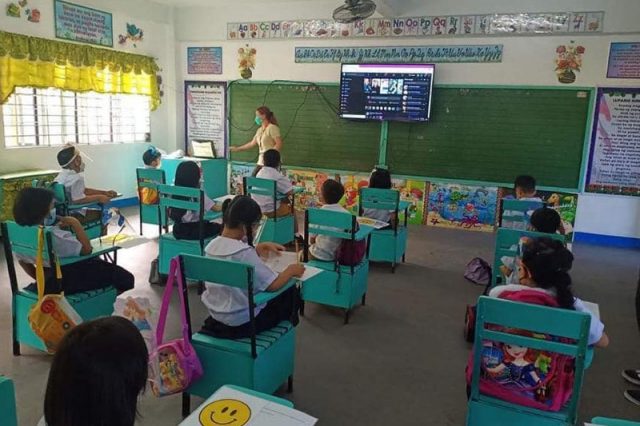
“Common sense solutions.”
A simulation of a classroom setup by Pasig City earned laudatory remarks for foregoing plastic barriers.
Pasig City Mayor Vico Sotto on Wednesday shared how the Pasig Elementary School is preparing to hold limited face-to-face classes that are set to start on December 6.
He posted pictures of a dry run of students entering the school premises and learning inside a classroom with a television screen on top of the blackboard.
The screen is supposed to feature the rest of their classmates who are in distance learning mode or those using a teleconferencing platform to attend class.
“Gaya ng sabi ng maraming eksperto — the (key emoji) is good ventilation and air flow!” Sotto said in a Facebook post.
He also thanked the parents who have consented to allow their children to participate in the dry run of the face-to-face classes.
For now, Pasig Elementary School’s “new normal” class setup is being validated before it gets greenlit to hold physical classes.
Others that are similarly being validated are Nagpayong Elementary School, F. Legaspi Memorial School and Pasig Ugong National High School.
Sotto’s post impressed Filipinos who noted the lack of plastic barriers in the dry run.
“Good ventilation and airflow? Practical solutions? Makes me so happy to see common sense solutions!” a Twitter user said.
“Mayor Vico understood the assignment. Ganito dapat! Evidence-based governance, none of that plastic barrier crap,” another online user wrote.
“Good to see that the Pasig City LGU (local government unit) did not waste money on plastic shields! This goes to show that the local government’s decision is based on actual research. Hindi pinagsamantalahan ang pandemya para makakurakot,” a user from Facebook said.
Plastic barriers have been featured in most classroom setups since the pilot implementation of limited physical classes has officially kicked off at national level.
RELATED: Isko Moreno told: Prioritize airflow over barriers in classrooms as classes start
The classroom setups previously concerned Filipinos who suggested that schools improve the ventilation of classrooms instead of installing barriers that have been proven to be ineffective in terms of mitigating COVID-19 transmission.
The virus causing COVID-19 can be transmitted through very fine respiratory droplets and aerosolized particles, according to the United States’ Centers for Disease Control and Prevention.
These are released when people breathe, sing, speak, exercise, cough and sneeze.
They can remain suspended in the air for hours in poorly ventilated and enclosed spaces.
ALSO READ: Ventilation over plastic barriers: Suggestions as limited onsite classes resume
A report by New York Times last August argued that plastic barriers “do little to stop the spread of the coronavirus.”
It said that under normal conditions, exhaled breath particles in classrooms, stores and offices disperse, get carried by air currents and then get replaced by fresh air around every 15 to 20 minutes, depending on the ventilation system.
The report said that installing plastic barriers can change the air flow in a room, disrupt normal ventilation and create “dead zones” where viral aerosol particles can build up and become highly concentrated.
“If you have a forest of barriers in a classroom, it’s going to interfere with proper ventilation of that room,” Linsey Marr, professor of civil and environmental engineering at Virginia Tech, was quoted as saying before.
“Everybody’s aerosols are going to be trapped and stuck there and building up, and they will end up spreading beyond your own desk,” she added.









